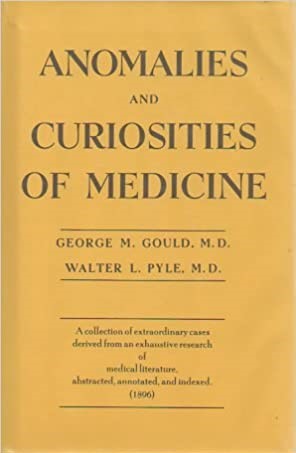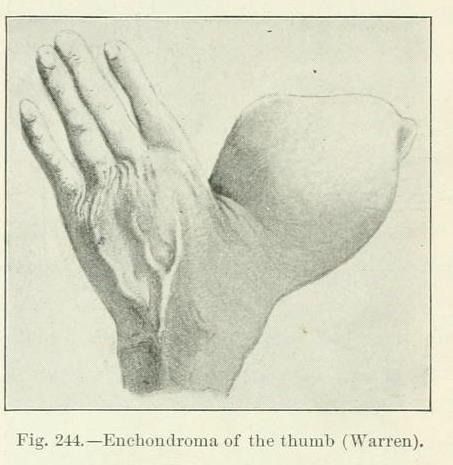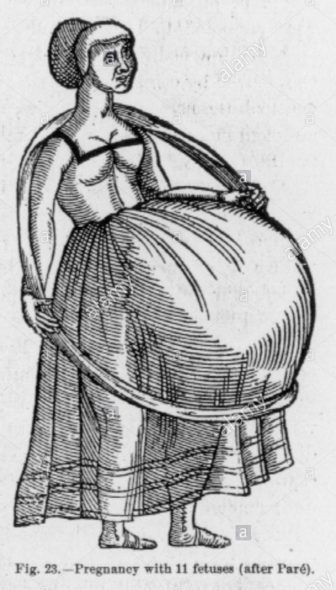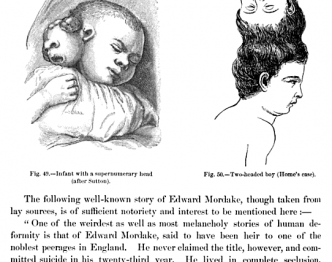 ANOMALIES AND CURIOSITIES OF MEDICINE by George M. Gould and Walter L. Pyle is easily the most famous and widely read medical text of all time, and with good reason. Initially published in 1896, the book is explained by its title page, which proclaims it “An Encyclopedic Collection of Rare and Extraordinary Cases, and of the Most Striking Instances of Abnormality in All Branches and Medicine and Surgery,” apparently derived from “An Exhaustive Research of Medical Literature from its Origin to the Present Day.”
ANOMALIES AND CURIOSITIES OF MEDICINE by George M. Gould and Walter L. Pyle is easily the most famous and widely read medical text of all time, and with good reason. Initially published in 1896, the book is explained by its title page, which proclaims it “An Encyclopedic Collection of Rare and Extraordinary Cases, and of the Most Striking Instances of Abnormality in All Branches and Medicine and Surgery,” apparently derived from “An Exhaustive Research of Medical Literature from its Origin to the Present Day.”
In their introduction the authors note that no comprehensive grouping of medical curiosities yet existed. Hence ANOMALIES AND CURIOSITIES OF MEDICINE, which runs nearly a thousand pages, and contains profuse illustrations, most of them of the pen-and-ink variety (hence, of the many versions of this book currently available online the ones to peruse are those that reproduce said illustrations, rather than the text-only formats being peddled on Amazon and elsewhere). In this respect ANOMALIES AND CURIOSITES OF MEDICINE can be viewed as the true inception of the countless books (such as Oliver Sachs’ THE MAN WHO MISTOOK HIS WIFE FOR A HAT) and other media (such as TV’S HOUSE) that pivot on medical anomalies. To this day, however, George Gould and Walter Pyle’s tome has yet to be matched in volume or variety.
Detailed in these pages are things like menstruation from the breasts (and also the eyes, mouth and ears), immaculate conception (or “Impregnation without completion of the copulative act”), rectal births, lactating men, the “odor of insanity,” spontaneous human combustion, ripped-out eyeballs (“in such cases, as a rule, the finger nails are the only instrument used”), bullets voided from the rectum, ear sneezing(!), the swallowing of various foreign objects (of which “Nearly every imaginable article from the minutest to the most incredible size has been reported”), compulsive chalk and clay eating, multi-colored saliva, “dancing mania” and so forth. That’s but a partial listing of the topics covered in this book, whose table of contents alone is a full nine pages long. Obviously this is not a casual or lighthearted read, and nor is it recommended for the squeamish.
Much of the info recited herein admittedly comes from ancient sources. As the authors concede, “It is noteworthy that in old-time medical  literature—sadly and unjustly neglected in our rage for the new—should so often be found parallels of our most wonderful and peculiar modern cases.” Such antiquated research, which utilizes sources like Homer, Herodotus and Aristotle alongside the prominent doctors and scientists of the day, explains why Gould and Pyle are often short on statistics. In a section on pregnant woman whose fetuses are devoured by maggots, for instance, the authors admit no real evidence exists for such claims, yet that doesn’t stop them from going into an enormous amount of detail on the subject.
literature—sadly and unjustly neglected in our rage for the new—should so often be found parallels of our most wonderful and peculiar modern cases.” Such antiquated research, which utilizes sources like Homer, Herodotus and Aristotle alongside the prominent doctors and scientists of the day, explains why Gould and Pyle are often short on statistics. In a section on pregnant woman whose fetuses are devoured by maggots, for instance, the authors admit no real evidence exists for such claims, yet that doesn’t stop them from going into an enormous amount of detail on the subject.
I don’t believe the authors’ use of unverified facts lessens the book’s impact, nor, as some critics have claimed, that Gould and Pyle’s primary goal was sensationalism—although I don’t entirely rule out that aspect. It’s hardly coincidental that ANOMALIES AND CURIOSITIES OF MEDICINE hails from the same era in which P.T. Barnum rose to fame and fortune displaying human oddities.
I happen to own another medical textbook, a thick tome from the 1930s called SURGICAL ERRORS AND SAFEGUARDS, which is heavily illustrated with gruesome illustrations amid a lot of dense and medical jargon-heavy verbiage. Where ANOMALIES AND CURIOSITIES OF MEDICINE differs from SURGICAL ERRORS… and its fellows, aside from its thorough (some might even say unhealthy) concentration on the freakish and bizarre, is in its readability. Perhaps because of the sheer volume of cases it presents (which, as the authors admit in their introduction, number in the thousands) there’s little in way of introspection or instruction, resulting in a book that’s lively and fast moving despite the oft-stilted formality and detachment of the prose.
 It’s in the textual area that ANOMALIES AND CURIOSITIES OF MEDICINE does recall other medical books, whose unrelentingly clinical and emotionless prose is affected quite noticeably in these pages. Little in the way of sympathy or understanding is offered the many, many unfortunates whose maladies are so voluminously described; the sentence “The coexistence of an extensive tumor of the uterus with pregnancy does not necessarily mean that the product of conception will be blighted” (how reassuring!) is about as sentimental as the authors allow themselves to get.
It’s in the textual area that ANOMALIES AND CURIOSITIES OF MEDICINE does recall other medical books, whose unrelentingly clinical and emotionless prose is affected quite noticeably in these pages. Little in the way of sympathy or understanding is offered the many, many unfortunates whose maladies are so voluminously described; the sentence “The coexistence of an extensive tumor of the uterus with pregnancy does not necessarily mean that the product of conception will be blighted” (how reassuring!) is about as sentimental as the authors allow themselves to get.
Getting back to the P.T. Barnum connection, the book’s most famous, and notorious, passages occur in chapters five (“Major Terata”), six (“Minor Terata”) and seven (“Anomalies of Stature, Size and Development”), which deal with human abnormalities (and were turned into a standalone ebook entitled FREAKS: AN ILLUSTRATED HISTORY OF THE MAJOR AND MINOR TERATA by Elektron Ebooks in 2013), thus making this the granddaddy of what MURDER CAN BE FUN’S Johnny Marr once termed ““Look, they’re Freaks!” books.” Such books, which proliferated in the late 20th Century, include Max Rusid’s SIDESHOW, Martin Monestier’s HUMAN ODDITIES, Frederick Drimmer’s VERY SPECAL PEOPLE and Daniel P. Mannix’s FREAKS: WE WHO ARE NOT AS OTHERS, all of which repeat information contained in ANOMALIES AND CURIOSITIES OF MEDICINE. (I’m guessing David Cronenberg also perused these sections, as certain illustrations, such as that of a woman with a mammary gland growing out of her armpit, directly recall certain imagery from his films.)
The term “freak,” it should be noted, isn’t used in these pages, which utilize apparently more palatable words like “terata” and “monster”(!). All the classic human oddities—the conjoined twins Chang and Eng, Jo-Jo the Dog Faced Boy, Felix the Elastic-Skin Man, Tom Thumb—are covered, as are related topics like pygmy tribes, albinism, people born with extra arms and legs, malformed fetuses, human tails, extreme spinal curvature, etc. Being the exhaustive researchers they were, Gould and Pyle are also careful to include info on more esoteric terata-related subject matter like hermaphroditism, mutated labia, testicular fusion and horned penises (detailed drawings of which are helpfully included).
Then there are more aberrant topics whose very mention must have shocked 1890s readers mightily. Included in this category are chapters  on cannibalism and other such “Depraved Appetites,” as well as “Idiosyncrasies in Coitus,” “Pain as a Means of Sexual Enjoyment” (the term sadomasochism didn’t exist in 1896) and castration (self and otherwise), all related in the same detached and unemotional tone that pervades the rest of the book.
on cannibalism and other such “Depraved Appetites,” as well as “Idiosyncrasies in Coitus,” “Pain as a Means of Sexual Enjoyment” (the term sadomasochism didn’t exist in 1896) and castration (self and otherwise), all related in the same detached and unemotional tone that pervades the rest of the book.
Whatever complaints I may have about the text, it’s a fact that few (if any) books from the 1890s have the power to shock, fascinate, outrage, enlighten and disturb modern readers the way this one does. ANOMALIES AND CURIOSITIES OF MEDICINE is, in short, a one-of-a-kind work, regardless of all the like-minded media that followed in its wake.
